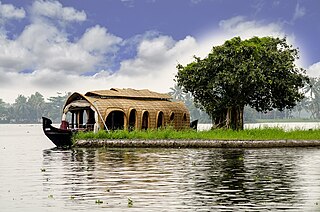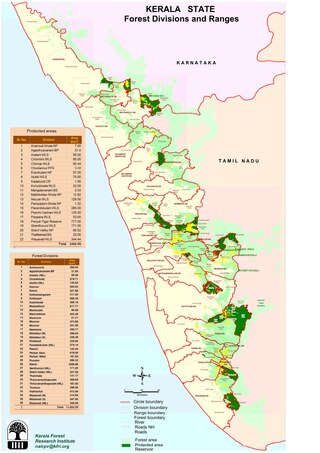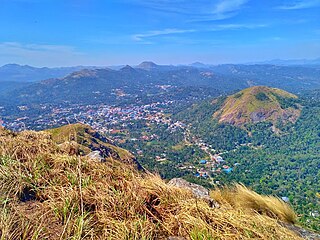
Alappuzha district, is one of the 14 districts in the Indian state of Kerala. It was formed as Alleppey district on 17 August 1957, the name of the district being changed to Alappuzha in 1990. It is the smallest district of Kerala. Alleppey town, the district headquarters, was renamed Alappuzha in 2012, even though the anglicised name is still commonly used to describe the town as well as the district.

Cardamom, sometimes cardamon or cardamum, is a spice made from the seeds of several plants in the genera Elettaria and Amomum in the family Zingiberaceae. Both genera are native to the Indian subcontinent and Indonesia. They are recognized by their small seed pods: triangular in cross-section and spindle-shaped, with a thin, papery outer shell and small, black seeds; Elettaria pods are light green and smaller, while Amomum pods are larger and dark brown.

Idukki is one of the 14 districts in the Indian state of Kerala in the southwest of the country. It is the largest district in Kerala and lies amid the Cardamom Hills of Western Ghats in Kerala. Idukki district contains two municipal towns - Kattappana and Thodupuzha, and five taluks.

The Cardamom Hills or Yela Mala are mountain range of southern India and part of the southern Western Ghats located in Idukki district, Kerala, India. Their name comes from the cardamom spice grown in much of the hills' cool elevation, which also supports pepper and coffee. The Western Ghats and Periyar Sub-Cluster including the Cardamom Hills are UNESCO World Heritage Sites.

Alappuzha or Alleppey is the administrative headquarters of Alappuzha district in state of Kerala, India. The Backwaters of Alappuzha are one of the most popular tourist attractions in India which attracts millions of domestic and international tourists.

Most of Kerala's native habitat, which consists of wet evergreen rainforests at lower elevations and highland deciduous and semi-evergreen forests in the east, has a humid tropical climate. However, significant variations in terrain and elevation lead to high biodiversity. But Alappuzha district has no forests.

The economy of Kerala is the 9th largest in India, with an annual gross state product (GSP) of ₹9.78 lakh crore in 2020–2021. Per-capita GSP of Kerala during the same period is ₹257,711 (US$3,200), the sixth largest in India. In 2019–20, the tertiary sector contributed around 63% of the state's GSVA, compared to 28% by secondary sector, and 8% by primary sector.

Kunnathur Kesavan Raman Pillai, also known as Raja Kesavadas was the Dewan of Travancore during the reign of Dharma Raja Karthika Thirunal Rama Varma. He is well known for his military tactics and administrative acumen. He was the mastermind in developing the Alappuzha town.

Peermade, also spelt Peerumedu is a village, Grama Panchayat and hill station in the state of Kerala, in southwestern India. It lies 915 metres (3,002 ft) above sea level in the Western Ghats (Sahyadri) about 85 kilometres (53 mi) east of Kottayam on the way to Thekkady through the nearby city of Kanjirappally.

Elettaria cardamomum, commonly known as green cardamom or true cardamom, is a herbaceous, perennial plant in the ginger family, native to southern India. It is the most common of the species whose seeds are used as a spice called cardamom that has a sharp, strong, punchy aroma. It is cultivated widely in tropical regions and reportedly naturalized in Réunion, Indochina, and Costa Rica.

Kumily, also spelt as Kumaly is a revenue village and Gram Panchayat in the Idukki district of the state of Kerala. It is a town in Cardamom Hills near Thekkady and Periyar Tiger Reserve. Kumily is a gateway town into Kerala from Tamil Nadu.

Kattappana stands as a vibrant municipal town nestled within the lush embrace of the Sahyadri in Kerala state, India. Positioned at an elevation of approximately 2,788.71–2,952.76 feet (850.00–900.00 m) above sea level, it proudly serves as the principal urban hub in the high ranges of Idukki district. This town holds the distinction of being the second to attain municipal status in the Idukki District. Renowned for its bustling commerce, Kattappana thrives on agriculture and spice production, shaping its identity as a significant commercial center.
Mannathara is a village in the Idukki District of Kerala on the southwest coast of India, located in the high ranges of the Western Ghats (Sahyadri). Mannathara is part of the Vathikudy Gramapanchayath and Idukki Talku. The word mannathra evolves from the name of a tribal group called Mannan. Mannans were the early inhabitants of in the region. It is believed that Mannans migrated from the dry plains of Tamil Nadu in search of livelihood in the hills. They were engaged in mainly hill cultivation of ragi, millet and rice as well as gathering cardamom, hill pepper, honey and other medicinal plants for exchange from the early period. The word Mannathra refers to a burial ground of the Mannan. The village had evidence of megalithic settlement sites. However, the majority of the material pieces of evidence to learn more about the prehistoric and early historic periods are not surviving. However, the ecological settings of this micro-region call attention from paleo-archaeologists. The continuous human intervention started in the mid-twentieth century destroyed most of the historically rich sites.
Nedumkandam is the headquarters of Udumbanchola taluk which is situated in Idukki district of the Indian state of Kerala. Nedumkandam is among the fastest growing towns in the Idukki district. Nedumkandam is well known for its spices production and is a major contributor to the production of spices like cardamom and pepper. This town situated an average elevation of 900 meter above sea level and maximum elevation respectively 1190 meter 1100 meter and 975 meter and is a destination for economical stay and shopping for tourists in the popular Kumily-Munnar tourist route.

The West Coast Canal or National Waterway No 3 is a 205 km (127 mi) long inland navigational route located in Kerala, India, which runs from Kollam to Kottapuram. It was declared a National Waterway in 1993. In addition to the main stretch, Champakara and Udyogmandal canals are navigable and connect the industrial centers of Kochi to Kochi port Inland Waterways Authority of India (IWAI) under the Ministry of Shipping is coordinating the task for developing, monitoring and administering national waterways. It is the first National Waterway in the country with 24-hour navigation facilities along the entire stretch. It has been extended to Kozhikode by the National Waterways Act, 2016. The National Waterway 3 mainly passes through the previous Thiruvananthapuram–Shoranur canal.

Alfred Vedam Thomas was an Indian businessman and politician, and a Member of the Legislative Assembly.

Anakkara is a geographic area of around 50 square kilometres that spans across Vandanmedu, Chakkupallam Panchayats in the Udumbanchola Taluk of Idukki District. Anakkara is the administrative capital of Chakkupallam Grama Panchayat and Anakkara Revenue Village. Situated at about 18 kilometers (11 mi) from Thekkady wildlife sanctuary on the Kumily-Munnar state highway, Anakkara is a fast-growing tourist destination for its unique spice gardens and many picnic spots in and around. It is one of the 36 distinct places identified by Government of India and United Nations Development Programme for exploring and promoting the unique tourism potential of these places.
Alleppy Coir refers to the Coir products made in Ambalappuzha and Cherthala Taluks of Alappuzha district, in the state of Kerala, India. Coir production of this region dates back to as early as 1859. The World Trade Organization (WTO) granted Geographical Indication status to "Alleppey Coir" in 2007.
Malabar pepper is a variety of black pepper that originated as a chance seedling in a geographical region that now forms part of the present-day state of Kerala in India. The area of production of this variety of pepper now covers all the regions that are part of the Malabar Coast. Malabar pepper was one of the commodities most sought after by the ancient Roman and Arab traders, and later by the early European navigators.
The High Ranges of Kerala is a hilly tract located across the Kerala state of southern India and is treated as a part of the Western Ghats.













